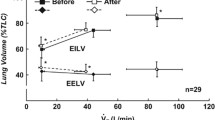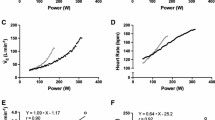Abstract
In order to evaluate the difference in the energy cost of submaximal cycling between normal weight (NW) and obese (OB) females, nine OB (age 23.2 years±1.6 SE, BMI 40.4±1.2 kg/m2) and nine NW (age 25.6 years±1.8, BMI 21.7±0.6 kg/m2) healthy young women were studied during a graded bicycle ergometer test at 40, 60, 80, 100 and 120 W. At rest and at all workloads, oxygen uptake \((\dot{V}{\text{O}}_{2})\) was higher in OB than in NW women (Student’s t test, P<0.05–0.01), as well as respiratory quotient during all exercise levels (P<0.05–0.01), while similar values of heart rate, pulmonary ventilation and breathing efficiency were found between the two groups. Maximal \(\dot{V}{\text{O}}_{2}\) and anaerobic threshold were higher in OB women, and they also explained the higher oxygen pulse observed during submaximal exercise, but no difference was found when the values were adjusted for fat-free mass. While net mechanical efficiency (ME) was significantly lower in OB (ANOVA, P<0.05), delta ME was similar in both groups, indicating no substantial derangement of muscle intrinsic efficiency in obesity, but suggesting that the increased mass of body segments involved in cycling movements may be chiefly responsible for the higher energy cost of this type of exercise. Comparison of the actual \(\dot{V}{\text{O}}_{2}\) presently measured with that predicted by available cycle ergometry equations at the different workloads indicated inaccuracy of various degrees ranging from 8.4 to −31.9%. It is concluded that the lower mechanical efficiency displayed by obese women in cycling has to be taken into account when prescribing exercise through methods predicting the metabolic load.




Similar content being viewed by others
References
American College of Sport Medicine (1991) Guidelines for exercise testing and prescription. Lea & Febiger, Philadelphia, pp 98–101
Andersen RE, Wadden TA (1995) Validation of a cycle ergometry equation for predicting steady-rate VO2 in obese women. Med Sci Sports Exerc 27:1457–1460
Anton-Kuchly B, Roger P, Varene P (1984) Determinants of increased energy cost of submaximal exercise in obese subjects. J Appl Physiol 56:18–23
van Baak MA (1999) Exercise training and substrate oxidation in obesity. Int J Obes 23(Suppl 3):S11–S17
Berry MJ, Storsteen JA, Woodard CM (1993) Effects of body mass on exercise efficiency and \(\dot{\rm V}{\text{O}}_{2}\) during steady-state cycling. Med Sci Sports Exerc 25:1031–1037
Chen KY, Acra SA, Donahue CL, Sun M, Buchowski MS (2004) Efficiency of walking and stepping: relationship to body fatness. Obes Res 12:982–989
Cotes JE (1969) Relationship of oxygen consumption, ventilation and cardiac frequency to body weight during standardized submaximal exercise in normal subjects. Ergonomics 12:415–427
Coyle EF, Sidossis LS, Horowitz JF, Beltz JD (1992) Cycling efficiency is related to the percentage of type I muscle fibers. Med Sci Sports Exerc 24:782–788
Dempsey JA, Reddan W, Balke B, Rankin J (1966) Work capacity determinants and physiologic cost of weight-supported work in obesity. J Appl Physiol 21:1815–1820
Francescato MP, Girardis M, di Prampero PE (1995) Oxygen cost of internal work during cycling. Eur J Appl Physiol Occup Physiol 72:51–57
Garby L, Astrup A (1987) The relationship between the respiratory quotient and the equivalent of oxygen during simultaneous glucose and lipid oxidation and lipogenesis. Acta Physiol Scand 129:443–444
Goran M, Fields DA, Hunter GR, Herd SL, Weinsier RL (2000) Total body fat does not influence maximal aerobic capacity. Int J Obes 24:841–848
Gray DS, Bray GA, Gemayel N, Kaplan K (1989) Effects of obesity on bioelectrical impedance. Am J Clin Nutr 50:255–260
Han TS, Tijhuis MA, Lean ME, Seidall JC (1998) Quality of life in relation to overweight and body fat distribution. Am J Public Health 88:1814–1820
Hesser CM, Lind F, Linnarsson D (1990) Significance of airway resistance for the pattern of breathing and lung volumes in exercising humans. J Appl Physiol 68:1875–1882
Hulens M, Vansant G, Lysens R, Claessens AL, Muls E (2001) Exercise capacity in lean versus obese women. Scand J Med Sci Sports 11:305–309
Kress JP, Pohlman AS, Alverdy J, Hall JB (1999) The impact of morbid obesity on oxygen cost of breathing \((\dot{V}{\text{O}}_{2}\hbox{RESP})\) at rest. Am J Respir Crit Care Med 160:883–886
Kriketos AD, Baur LA, O’Connor J, Carey D, King S, Caterson ID, Storlien LH (1997) Muscle fibre type composition in infant and adult populations and relationships with obesity. Int J Obes 21:796–801
Lafortuna CL, Fumagalli E, Vangeli V, Sartorio A (2002) Lower limb alactic anaerobic power output assessed with different techniques in morbid obesity. J Endocrinol Invest 25:134–141
Lafortuna CL, Agosti F, Marinone PG, Marazzi N, Sartorio A (2004) The relationship between body composition and muscle power output in men and women with obesity. J Endocrinol Invest 27:854–861
Lafortuna CL, Maffiuletti NA, Agosti F, Sartorio A (2005) Gender variations of body composition, muscle strength and power output in morbid obesity. Int J Obes 29:833–841
Larsson U, Karlsson J, Sullivan M (2002) Impact of overweight and obesity on health-related quality of life—a Swedish population study. Int J Obes 26:417–424
Latin WR, Berg KE (1994) The accuracy of the ACSM and a new cycle ergometry equation for young women. Med Sci Sports Exerc 26:642–646
Latin WR, Berg KE, Smith P, Tolle R, Woody-Brown S (1993) Validation of a cycle ergometry equation for predicting steady-rate VO2. Med Sci Sports Exerc 25:970–974
Lukaski HC, Bolonchuk WW, Hall CB, Siders WA (1986) Validation of tetrapolar bioelectrical measurements to assess human body composition. J Appl Physiol 60:1327–1332
Mattsson E, Larsson UE, Rossner S (1997) Is walking for exercise too exhausting for obese women? Int J Obes 21:380–386
Moseley L, Jeukendrup AE (2001) The reliability of cycling efficiency. Med Sci Sports Exerc 33:621–627
Muller MJ, Bosy-Westphal A, Kutzner D, Heller M (2002) Metabolically active components of fat-free mass and resting energy expenditure in humans: recent lessons from imaging technologies. Obes Rev 3:113–122
Pelosi P, Croci M, Ravagnan I, Vicardi P, Gattinoni L (1996) Total respiratory system, lung, and chest wall mechanics in sedated-paralyzed postoperative morbidly obese patients. Chest 109:144–151
Rippe JM, Hess S (1998) The role of physical activity in the prevention and management of obesity. J Am Diet Assoc 98(Suppl 2):S31–S38
Salvadori A, Fanari P, Fontana M, Buontempi L, Saezza A, Baudo S, Miserocchi G, Longhini E (1999) Oxygen uptake and cardiac performance in obese and normal subjects during exercise. Respiration 66:25–33
Sartorio A, Proietti M, Marinone PG, Agosti F, Adorni F, Lafortuna CL (2004) Influence of gender, age and BMI on lower limb muscular power output in a large population of obese men and women. Int J Obes 28:91–98
Shih R, Wang Z, Heo M, Wang W, Heymsfield SB (2000) Lower limb skeletal muscle mass: development of dual-energy X-ray absorptiometry prediction model. J Appl Physiol 89:1380–1386
Wasserman K, Stringer WW, Casaburi R, Koike A, Cooper CB (1994) Determination of the anaerobic threshold by gas exchange: biochemical considerations, methodology and physiological effects. Z Kardiol 83(Suppl 3):1–12
Wing RR (1999) Physical activity in the treatment of adulthood overweight and obesity: current evidence and research issues. Med Sci Sports Exerc 31:S547–S552
World Health Organization (1998) Obesity: preventing and managing the global epidemic. Report of a WHO consultation on obesity. World Health Organization, Geneva
Zar JH (1984) Biostatistical analysis. Prentice-Hall, Englewood Cliff
Zarich SW, Kowalchuk GJ, McGuire MP, Benotti PN, Mascioli EA, Nesto RW (1991) Left ventricular filling abnormalities in asymptomatic morbid obesity. Am J Cardiol 68:377–381
Acknowledgements
The authors wish to thank Dr. P.G. Marinone, Mr. S. Ottolini and Mr. M. Jubeau (INSERM/ERIT-M 0207 Motricité-Plasticité, Faculté des Sciences du Sport, Université de Bourgogne, Dijon Cedex, France) for their technical support during exercise testing. Ms. F. Pera (headnurse) and the nursing staff at the 3rd Division of Metabolic Diseases supported the study with their professional skilfulness.
Author information
Authors and Affiliations
Corresponding author
Rights and permissions
About this article
Cite this article
Lafortuna, C.L., Proietti, M., Agosti, F. et al. The energy cost of cycling in young obese women. Eur J Appl Physiol 97, 16–25 (2006). https://doi.org/10.1007/s00421-006-0137-5
Accepted:
Published:
Issue Date:
DOI: https://doi.org/10.1007/s00421-006-0137-5




